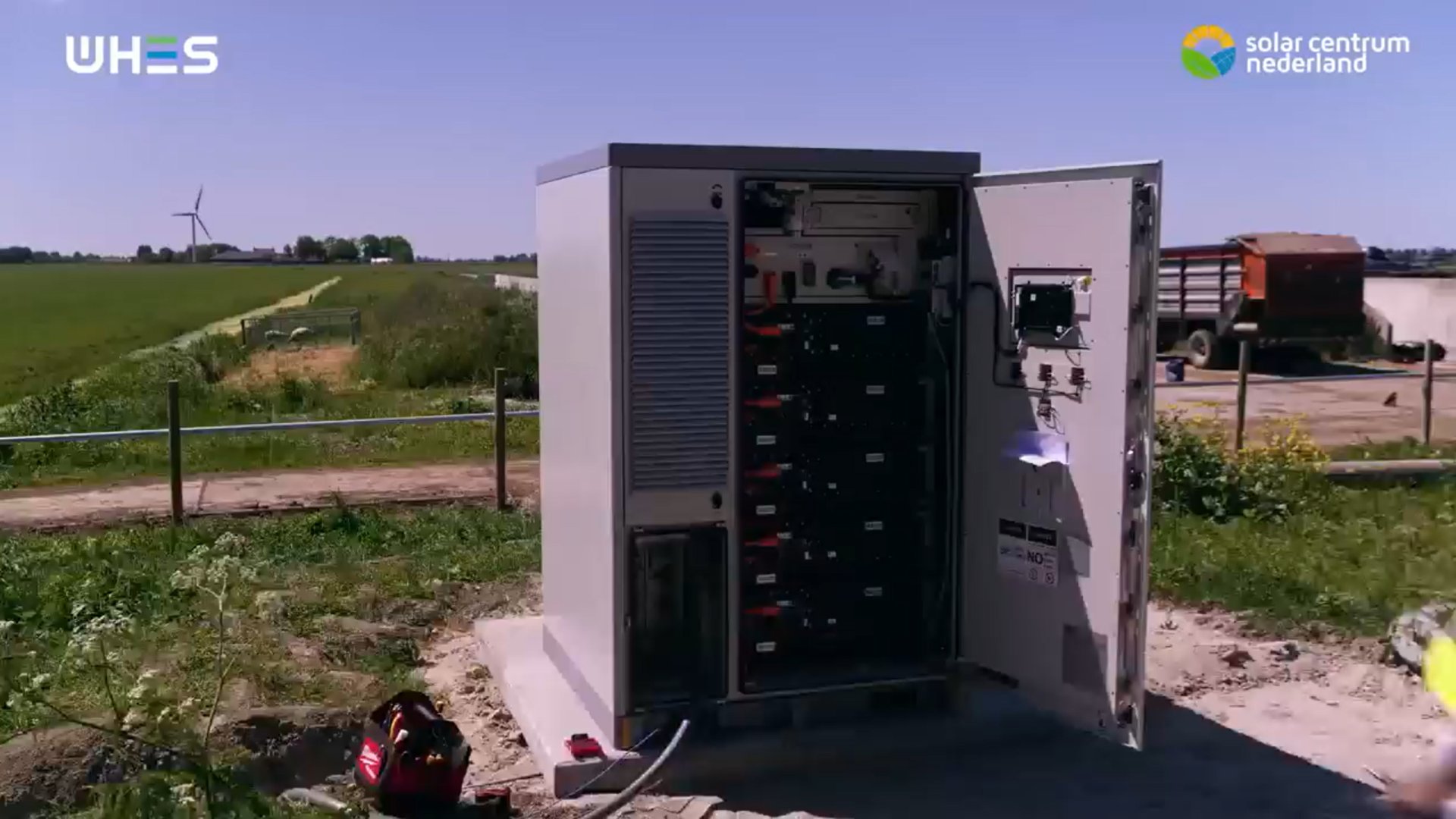
Case study: PowerCore in the Netherlands
Grid congestion threatens the Netherlands' green energy goals, but one Friesland farm is fighting back with a powerful battery solution. Discover how this state-of-the-art system prevents overloads, cuts costs, and creates the blueprint for a sustainable future.
CASE STUDY - COMMERCIAL
Connor Braddy
6/30/20256 min read

Friesland's Future: Tackling Grid Congestion with Smart Technology
In the picturesque, green landscapes of Friesland, Netherlands, a quiet revolution is taking place. This project is part of a broader modernisation of the electric grid in Friesland, aiming to enhance resilience, efficiency, and cybersecurity. Amidst the dairy cows and traditional barns, a state-of-the-art energy solution has been installed, marking a significant step forward in the fight against grid congestion and paving the way for a more sustainable energy future.
This project, a collaboration between Solar Centrum Nederland and Volta’s manufacturing partner WHES (Weiheng Energy Storage), showcases the practical power of battery energy storage systems (BESS) in a real-world agricultural setting in the town of Britswert. Smart electricity grids are transforming traditional electric grids and electrical grids by shifting from existing infrastructure to advanced, digitalised, and automated systems. Upgrading existing infrastructure is crucial to support new technologies like battery energy storage systems, ensuring that electrical grids and electric grids can efficiently integrate renewable energy and withstand modern challenges.
The Challenge: A Power Grid Under Pressure
As renewable energy sources like solar and wind become more prevalent, local grids (especially in rural areas) can struggle to handle the fluctuating power supply. Traditional grids, which rely on centralized power plants and unidirectional power distribution, often lack the flexibility and real-time monitoring needed to manage fluctuating electricity demand and efficient power distribution. When the sun shines brightly or the wind blows strong, a massive amount of energy is generated. This can lead to grid congestion, where the infrastructure is unable to manage the excess power, potentially causing instability and forcing a halt to new sustainable energy projects. Smart electricity grids address these challenges by improving the management of energy supply and demand, helping to alleviate grid congestion and maintain system stability.
The Solution: The PowerCore Energy Storage System
To address this challenge head-on, a PowerCore Energy Storage System was deployed. This isn’t just a simple battery; it’s an intelligent, robust solution designed for performance, safety, and grid optimisation. Digital technology is integral to the system’s intelligent operation, enabling real-time data management and advanced communication for optimal grid performance. The PowerCore is a key component of a modern power system, supporting the transition from traditional grids to advanced, interconnected power systems. Implementing smart grids is transforming how power systems operate by integrating automation, renewable energy, and improved efficiency. In this context, a smart grid represents a comprehensive, integrated management system that enhances grid reliability, flexibility, and the integration of renewable energy sources.
The key specifications of the Friesland installation include:
Power: 100kW
Capacity: 233kWh
System: 2-hour charge/discharge capability
This powerful unit acts as an energy reservoir. Its 100 kW AC side enables a bidirectional energy flow between the battery itself, the local solar (PV) installation, and the main power grid.
"Our smart energy platform is built to tackle complex grid challenges head-on. In Friesland, it's taking top-quality components from our partner WHES and turning them into an integrated solution that helps solve grid congestion. We're proud our approach is proving to be a real model for building a sustainable future."


Why This Renewable Energy Technology Excels
As highlighted by WHES, the PowerCore system is engineered with advanced features that make it ideal for such applications:
Premium Components: The system is built with high-quality CATL battery packs, a world leader in battery technology.
Advanced Thermal Management: An intelligent liquid cooling system maintains a precise temperature control with a fluctuation of ≤2∘C. This ensures optimal performance, extends the battery’s lifespan, and enhances safety.
Multi-Layer Safety: Safety is paramount. The unit features real-time thermal and smoke monitoring, coupled with an advanced Aerogel fire suppression system, and is fully EU-certified for safety and grid compliance.
The PowerCore system supports efficient energy generation and electricity generation from renewable sources, optimising energy production and storage for both centralised and decentralised applications. Unlike the centralised model of traditional power plants, smart grids enable decentralised energy production, allowing local sources to contribute to the grid and enhancing overall resilience. With PowerCore, users can generate energy, store it, and actively participate in smart power networks, helping to build a more sustainable and efficient energy infrastructure.
Bi-Directional Energy Flow: A New Era for Electricity Consumption
The rise of smart grid technology is ushering in a new era for electricity consumption, transforming the way energy is generated, distributed, and used across the Netherlands and beyond. Unlike traditional power grids, which rely on a one-way flow of electricity from centralised power plants through transmission lines to end users, smart grids enable a dynamic, bi-directional energy flow. This means that energy can move not just from the grid to homes and businesses, but also back from consumers to the grid itself.
This shift is made possible by advanced metering infrastructure and smart meters, which provide real-time data on energy use and allow for precise control over energy distribution. With these smart grid technologies in place, energy providers can better balance supply and demand, reducing energy waste and improving overall energy efficiency. Households and businesses equipped with rooftop solar panels or small wind turbines can now generate their own renewable energy, using what they need and feeding any excess energy back into the grid. This not only helps stabilise the power grid but also supports the integration of more renewable energy sources, such as solar and wind power, into the whole electricity supply system.
Bi-directional energy flow is also paving the way for new innovations in energy storage and electric vehicles. Smart load control switches and automated control systems can detect changes in energy demand and adjust the energy supply accordingly, ensuring that electricity consumption is always matched to what’s available. Electric vehicles, for example, can act as mobile energy storage systems, storing excess energy during periods of low demand and supplying it back to the grid when needed. This flexibility is crucial for managing the intermittent nature of renewable energies and maintaining grid stability.
According to the Electric Power Research Institute, implementing bi-directional energy flow can significantly reduce greenhouse gas emissions by making it easier to incorporate renewable energy sources and distributed energy resources into the energy system. It also reduces the need for long-distance transmission lines and centralized power plants, promoting a more decentralized and resilient energy infrastructure.
As the energy sector continues its transition towards a sustainable energy future, the benefits of bi-directional energy flow are becoming increasingly clear. It leads to lower energy consumption, greater energy efficiency, and a more reliable electricity supply system. By enabling two-way communication between energy providers and consumers, smart grids are not only optimising energy management but also empowering individuals and communities to play an active role in the energy transition. With continued investment in smart grid research and the adoption of advanced technologies, bi-directional energy flow is set to revolutionise power consumption and help build a cleaner, more sustainable energy system for generations to come.
Smart Grid Management for Real-World Benefits
The true strength of the installation lies in its intelligent operation. The system provides real-time energy management, automatically making decisions based on grid load and fluctuating market prices.
Here’s how it works:
Stores Off-Peak Power: The battery stores energy when it’s abundant and cheap, either from the farm’s own solar panels or from the grid during off-peak hours.
Prevents Overload: By absorbing excess solar generation, the system prevents overload on the local grid, allowing for sustainable growth.
Delivers During Peak Demand: When energy demand is high and prices are at their peak, the system discharges the stored power, reducing reliance on the grid and lowering energy costs.
The system enables users to closely monitor and optimise their energy usage and electricity usage, providing detailed insights that help identify opportunities to reduce consumption and improve efficiency. Smart grid technology also helps reduce energy bills and save energy for both consumers and utility providers by supporting demand response, integrating renewables, and minimising waste.
This capability opens up significant financial benefits, including smart trading on the energy imbalance market and a clear return on investment from a self-owned energy asset. It is, in essence, a way to future-proof a business for the coming sustainable energy era. This installation in Friesland is more than just a case study; it’s a blueprint for the future, demonstrating how innovative energy storage can empower farms, businesses, and communities to embrace renewable energy without limits. The future of energy is built on innovation. If you are developing a similar smart grid or energy storage project, we want to hear from you. Contact our team today to share your story.
Charged up?
Ready to learn more about our battery storage systems?
Get in touch with our experts today.


Registered office address
1501 Douglass Tower, 9 Goodluck Hope Walk, London E14 0XE
020 3297 7349
hello@voltaeco.co.uk
Company number 15724376









